Exploring the Effects of Nano-CaCO3 on the Core–Shell Structure and Properties of HDPE/POE/Nano-CaCO3 Ternary Nanocomposites
Abstract
:1. Introduction
2. Materials and Methods
2.1. Materials
2.2. Specimen Preparation
2.3. Characterizations
3. Results and Discussion
3.1. Prediction of the Phase Morphology
3.2. Effect of the Processing Method of the HDPE Nanocomposite Phase Structure
3.3. Effect of the Content of the Nano-CaCO3 of the Nanocomposite Phase Structure
3.4. Melt Rheological Behavior
3.5. Dynamic Mechanical Properties of Composites
3.6. Wide-Angle X-ray Diffraction
3.7. Mechanical Properties
4. Conclusions
Author Contributions
Funding
Institutional Review Board Statement
Data Availability Statement
Conflicts of Interest
References
- Lee, J.-G.; Jeong, J.-O.; Jeong, S.-I.; Park, J.-S. Radiation-based Crosslinking Technique for Enhanced Thermal and Mechanical Properties of HAPE/EVA/PU Blends. Polymers 2021, 13, 2832. [Google Scholar] [CrossRef]
- Park, J.-S.; Lim, Y.-M.; Nho, Y.-C. Preparation of High Density Polyethylene/Waste Polyurethane Blends Compatibilized with Polyethylene-graft-maleic Anhydride by Radiation. Materials 2015, 8, 1626–1635. [Google Scholar] [CrossRef] [PubMed]
- Shen, C.; Zhou, Y.; Dou, R.; Wang, W.; Yin, B.; Yang, M.B. Effect of the Core-Forming Polymer on Phase Morphology and Mechanical Properties of PA6/EPDM-g-MA/HDPE Ternary Blends. Polymer 2015, 56, 395–405. [Google Scholar] [CrossRef]
- Aigbodion, A.I.; Ressia, J.A.; Ciolino, A.E.; Failla, M.D.; Vallés, E.M. Effect of the Vinyl Concentration on the Structural and Rheological Characteristics of Peroxide-modified High-Density Polyethylenes. J. Appl. Polym. Sci. 2010, 115, 1942–1951. [Google Scholar] [CrossRef]
- Ngu, J.; Noshida, I.; Akmil, M.; Chuah, A.L.; Chantar, R. Thermal Properties of Low-Density Polyethylene/ALPHA- Alumina Nanocomposites. J. Thermoplast. Compos. 2012, 25, 415–426. [Google Scholar] [CrossRef]
- Chen, F.; Shangguan, Y.; Jiang, Y.; Qiu, B.; Luo, G.; Zheng, Q. Toughening with little rigidity loss and mechanism for modified polypropylene by polymer particles with core–shell structure. Polymer 2015, 65, 81–92. [Google Scholar] [CrossRef]
- Zhu, L.; Wang, H.; Liu, M.; Jin, Z.; Zhao, K. Effect of Core-Shell Morphology on the Mechanical Properties and Crystallization Behavior of HDPE/HDPE-g-MA/PA6 Ternary Blends. Polymers 2018, 10, 1040. [Google Scholar] [CrossRef] [PubMed]
- Guimarães, M.J.O.C.; Coutinho, F.M.B.; Rocha, M.C.G.; Garcia, M.E.F. Preparation and Characterization of Blends of High Density Polyethylene and Poly(ethylene-co-1-octene) Elastomer. J. Appl. Polym. Sci. 2001, 81, 1991–1995. [Google Scholar] [CrossRef]
- Quitadamo, A.; Massardier, V.; Santulli, C.; Valente, M. Optimization of Thermoplastic Blend Matrix HDPE/PLA with Different Types and Levels of Coupling Agents. Materials 2018, 11, 2527. [Google Scholar] [CrossRef]
- Gao, Z.; Wang, Y.; Zhang, B.; Liu, L.; Liu, X. Enhanced Thermal Conductivity of High-Density Polyethylene Composites with Hybrid Fillers of Flaky and Spherical Boron Nitride Particles. Polymers 2024, 16, 268. [Google Scholar] [CrossRef]
- Ali, I.; Elleuthy, R. Toughness of HDPE/CaCO3 Microcomposites Prepared from Masterbatch by Melt Blend Method. J. Appl. Polym. Sci. 2011, 122, 3303–3315. [Google Scholar] [CrossRef]
- Lu, B.; Zheng, G.Q.; Dai, K.; Liu, C.T.; Chen, J.B.; Shen, C.Y. Enhanced Mechanical Properties of Polyethylene Composites with Low Content of Electrospun Nylon-66 Nanofibers. Mater. Lett. 2015, 140, 131–134. [Google Scholar] [CrossRef]
- Pang, H.; Yan, D.X.; Bao, Y.; Chen, J.B.; Chen, C.; Li, Z.M. Super-tough Conducting Carbon Nanotube/Ultrahigh-Molecular-Weight Polyethylene Composites with Segregated and Double-Percolated Structure. J. Mater. Chem. 2012, 22, 23568–23575. [Google Scholar] [CrossRef]
- Fouad, H.; Elleithy, R.; Al-Zahrani, S.M.; Ali, M.A. Characterization and Processing of High Density Polyethylene/Carbon Nano-composites. Mater. Design 2011, 32, 1974–1980. [Google Scholar]
- Wu, S.S.; Ran, Q.P.; Shen, J. Effect of Light Intensity on Ultraviolet Irradiated Polypropylene and Its Compatibilization with CaCO3. J. Thermoplast. Compos. 2010, 23, 149–159. [Google Scholar] [CrossRef]
- Pöllänen, M.; Pelz, U.; Suvanto, M.; Pakkanen, S.T. Effective Method for Dispersing SiO2 Nanoparticles into Polyethylene. J. Appl. Polym. Sci. 2010, 116, 1218–1225. [Google Scholar] [CrossRef]
- Tjong, S.C.; Bao, S.P. Fracture Toughness of High Density Polyethylene/SEBS-g-MA/Montmorillonite Nanocomposites. Compos. Sci. Technol. 2007, 67, 314–323. [Google Scholar] [CrossRef]
- Liu, Z.H.; Kwok, K.W.; Li, R.K.Y. Effects of Coupling Agent and Morphology on the Impact Strength of High Density Polyethylene/CaCO3 Composites. Polymer 2002, 43, 2501–2506. [Google Scholar] [CrossRef]
- Rastin, H.; Saeb, M.R.; Jafari, S.H.; Khonakdar, H.A.; Kritzschmar, B.; Wagenknecht, U. Reactive Compatibilization of Ternary Polymer Blends with Core-Shell Type Morphology. Macromol. Mater. Eng. 2015, 300, 86–98. [Google Scholar] [CrossRef]
- Zhou, Y.; Wang, W.; Dou, R.; Li, L.P.; Yin, B.; Yang, M.B. Effect of EPDM-g-MAH on the Morphology and Properties of PA6/EPDM/HDPE Ternary Blends. Polym. Eng. Sci. 2013, 53, 1845–1855. [Google Scholar] [CrossRef]
- Mallick, S.; Dhibar, A.K.; Khatua, B.B. Effect of Nanoclay on the Morphology and Properties of Poly(methyl methacrylate)/High-Density Polyethylene Blends. J. Appl. Polym. Sci. 2010, 116, 1010–1020. [Google Scholar] [CrossRef]
- Li, L.P.; Yin, B.; Zhou, Y.; Gong, L.; Yang, M.B.; Xie, B.H.; Chen, C. Characterization of PA6/EPDM-g-MA/HDPE Ternary Blends: The Role of Core-shell Structure. Polymer 2012, 53, 3043–3051. [Google Scholar] [CrossRef]
- Valera, T.S.; Morita, A.T.; Demarquette, N.R. Study of Morphologies of PMMA/PP/PS Ternary Blends. Macromolecules 2006, 39, 2663–2675. [Google Scholar] [CrossRef]
- Gahleitner, M.; Pham, T.; Machl, D. Polyolefin Blends with Selectively Crosslinked Disperse Phase Based on Silane-Modified Polyethylene. Polymers 2023, 15, 4692. [Google Scholar] [CrossRef] [PubMed]
- Wu, S. Polymer Interface and Adhesion; Marcel Dekker: New York, NY, USA, 1982; pp. 89–90. [Google Scholar]
- Hajibabazadeh, S.; Aghjeh, M.K.R.; Palahang, M. Study on the Fracture Toughness and Deformation Micro-mechanisms of PP/EPDM/SiO2 Ternary Blend-nanocomposites. J. Compos. Mater. 2020, 54, 591–605. [Google Scholar] [CrossRef]
- Hajibabazadeh, S.; Aghjeh, M.K.R.; Mazidi, M.M. Stiffness-toughness Balance in PP/EPDM/SiO2 Ternary Blend-nanocomposites: The Role of Microstructural Evolution. J. Compos. Mater. 2021, 55, 265–275. [Google Scholar] [CrossRef]
- Hajibabazadeh, S.; Aghjeh, M.K.R.; Mazidi, M.M. Processing–microstructure–fracture Toughness Relationships in PP/EPDM/SiO2 Blend-nanocomposites: Effect of Mixing Sequence. Polym. Eng. Sci. 2024; in press. [Google Scholar] [CrossRef]
- Chen, X.L.; Yu, J.; Luo, Z.; Guo, S.Y.; He, M.; Zhou, Z.W. Study on Mechanical Properties and Phase Morphology of Polypropylene/Polyolefin Elastomer/Magnesium Hydroxide Ternary Composites. Polym. Advan. Technol. 2011, 22, 657–663. [Google Scholar] [CrossRef]
- Joshi, M.; Butola, B.S.; Simon, G.; Kukaleca, N. Rheological and Viscoelastic Behavior of HDPE/Octamethyl-POSS Nanocomposites. Macromolecules 2006, 39, 1839–1849. [Google Scholar] [CrossRef]
- Couch, M.A.; Binding, D.M. High Pressure Capillary Rheometry of Polymeric Fluids. Polymer 2000, 41, 6323–6334. [Google Scholar] [CrossRef]
- Gautam, S.; Arup, C. Dynamic Mechanical and Thermal Properties of PE-EPDM Based Jute Fiber Composites. J. Appl. Polym. Sci. 2008, 108, 3442–3453. [Google Scholar]
- López-Cabrera, H.R.; Figueroa-López, U.; Taylor, A.C.; Guevara-Morales, A. Dynamic Fracture Resistance under Plane Strain Conditions of High-Density Polyethylene Nanoclay Composites. Polymers 2023, 15, 813. [Google Scholar] [CrossRef] [PubMed]
- Kutlay, S.; Ismail, H.T.; Yoldas, S. Electrical and mechanical properties of expanded graphite/high density polyethylene nanocomposites. Compos. Part. B Eng. 2013, 53, 226–233. [Google Scholar]
- Kim, S.; Do, I.; Drzal, L.T. Thermal Stability and Dynamic Mechanical Behavior of Exfoliated Graphite Nanoplatelets-LLDPE Nanocomposites. Polym. Compos. 2010, 31, 755–761. [Google Scholar] [CrossRef]
- Gu, J.; Xu, H.; Wu, C. Thermal and Crystallization Properties of HDPE and HDPE/PP Blends Modified with DCP. Adv. Polym. Tech. 2014, 33, 21384. [Google Scholar] [CrossRef]
- Wang, Y.X.; Wang, C.-C.; Shi, Y.; Liu, L.-Z.; Bai, N.; Song, L.-F. Effects of Dynamic Crosslinking on Crystallization, Structure and Mechanical Property of Ethylene-Octene Elastomer/EPDM Blends. Polymers 2022, 14, 139. [Google Scholar] [CrossRef]
- Shen, Y.; Xie, A.; Chen, Z.; Xu, W.; Yao, H.; Li, S.; Huang, L.; Wu, Z.; Kong, X. Controlled Synthesis of Calcium Carbonate Nanocrystals with Multi-morphologies in Different Bicontinuous Microemulsions. Mater. Sci. Eng. A 2007, 443, 95–100. [Google Scholar] [CrossRef]
- Patterson, A.L. The Scherrer Formula for X-Ray Particle Size Determination. Phys. Rev. 1939, 56, 978–982. [Google Scholar] [CrossRef]
- Ma, C.G.; Mai, Y.L.; Rong, M.Z.; Ruan, W.H.; Zhang, M.Q. Phase Structure and Mechanical Properties of Ternary Polypropylene/Elastomer/Nano-CaCO3 Composites. Compos. Sci. Technol. 2007, 67, 2997–3005. [Google Scholar] [CrossRef]


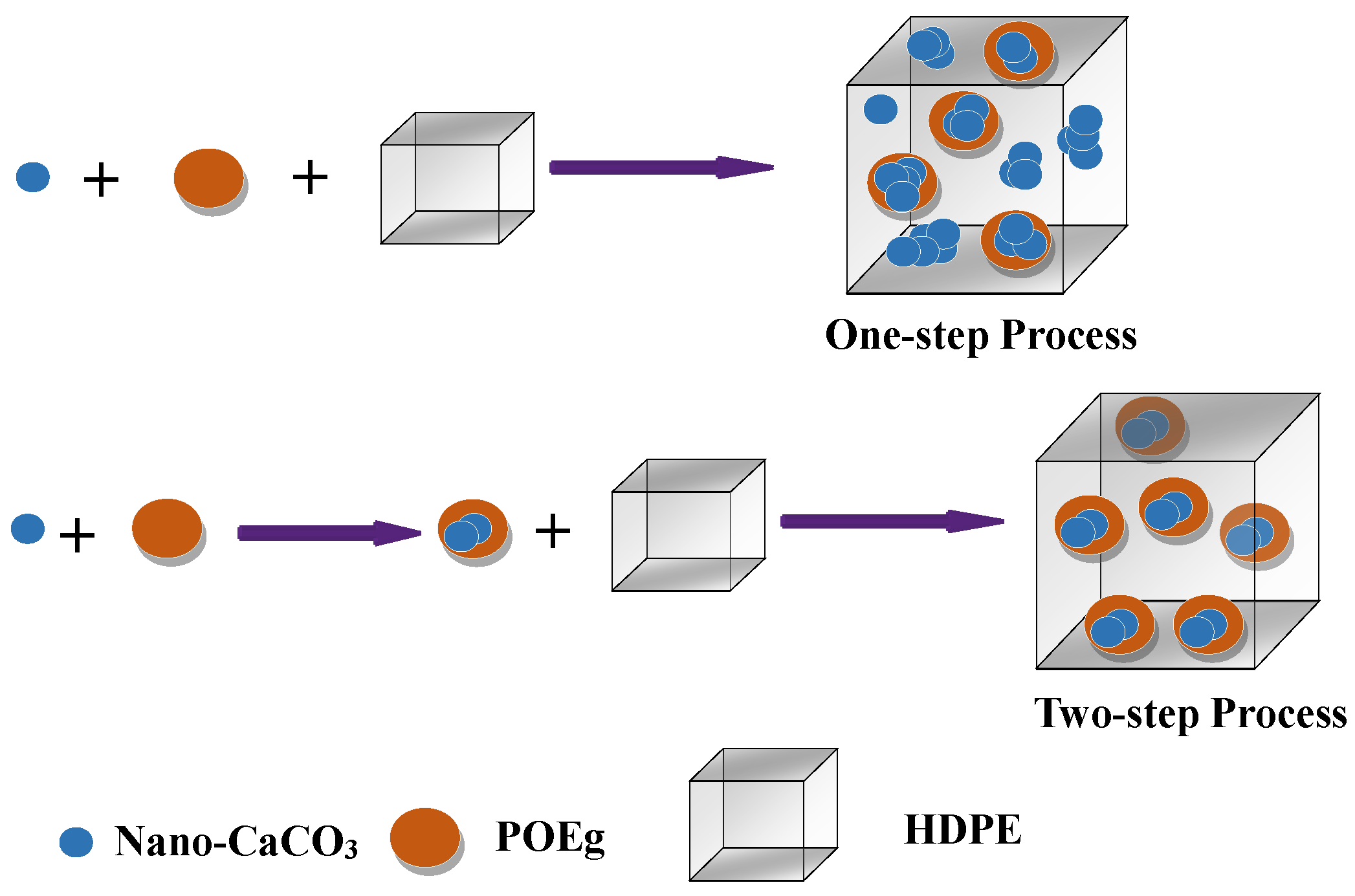
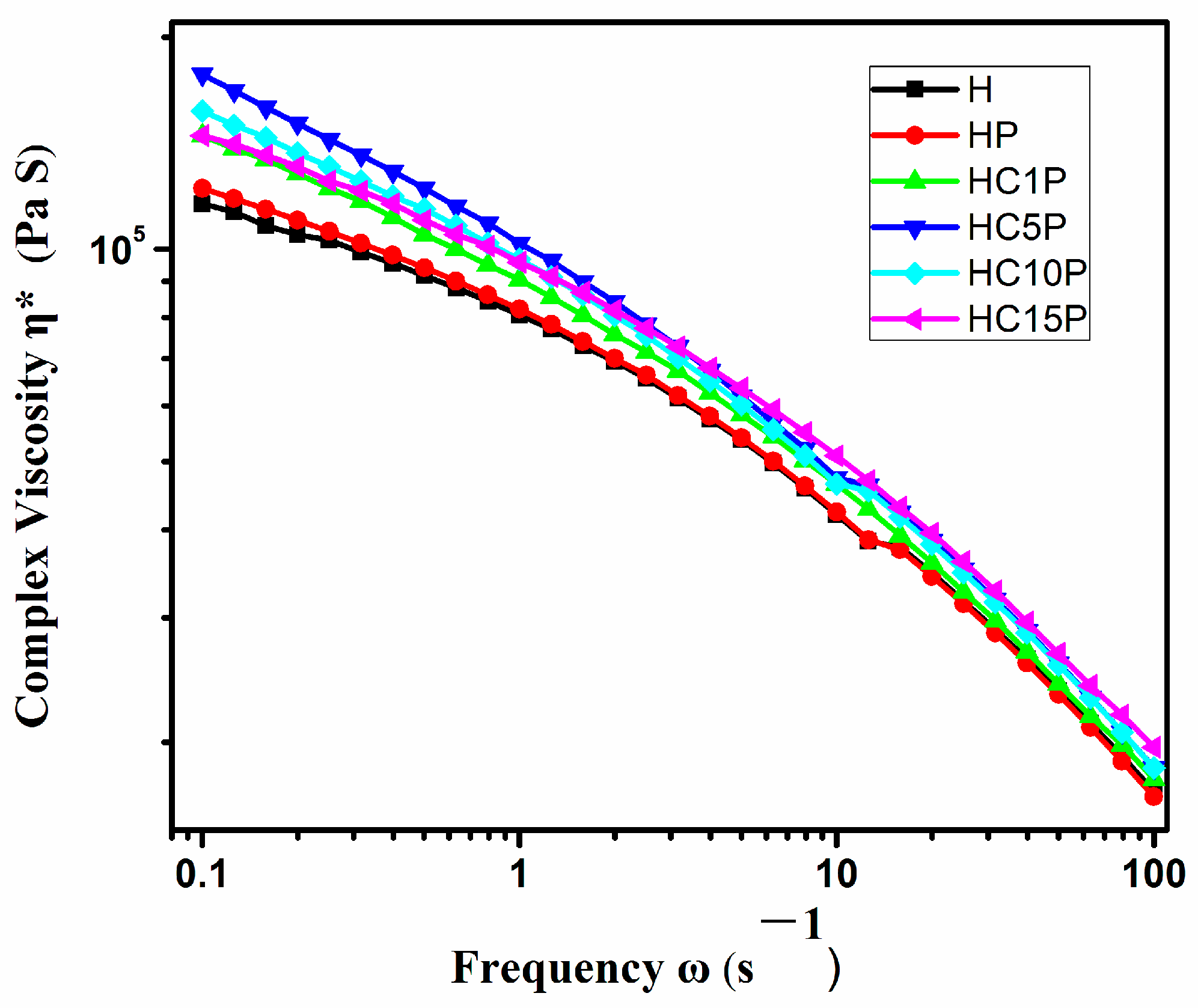
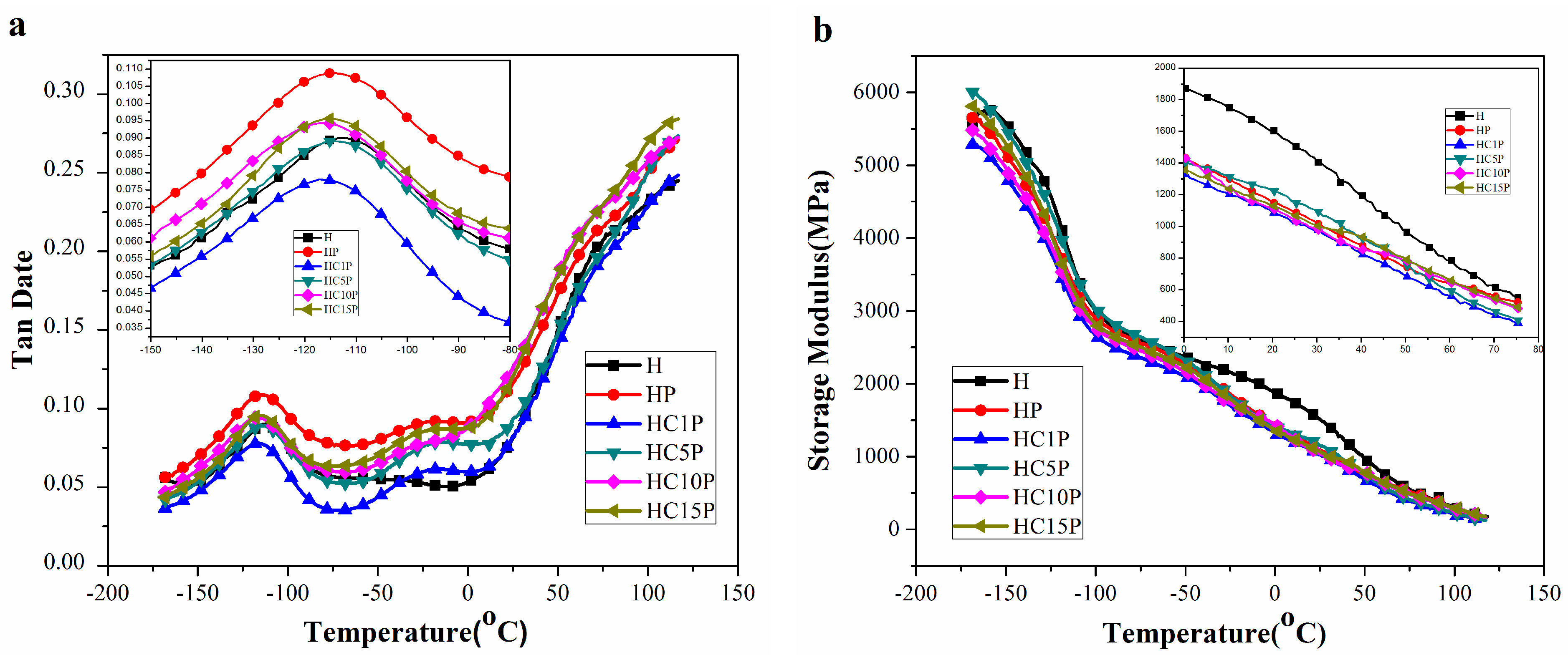

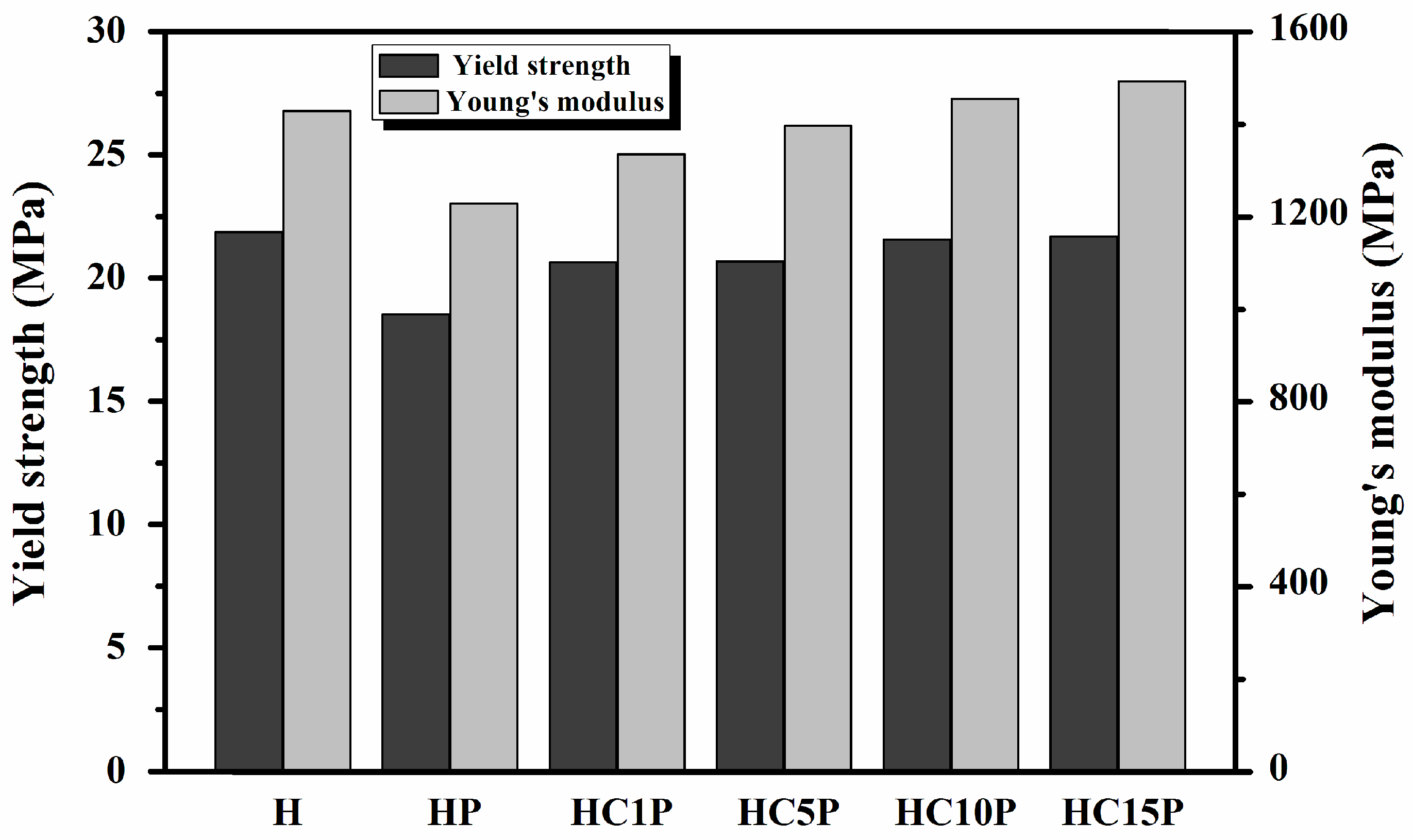

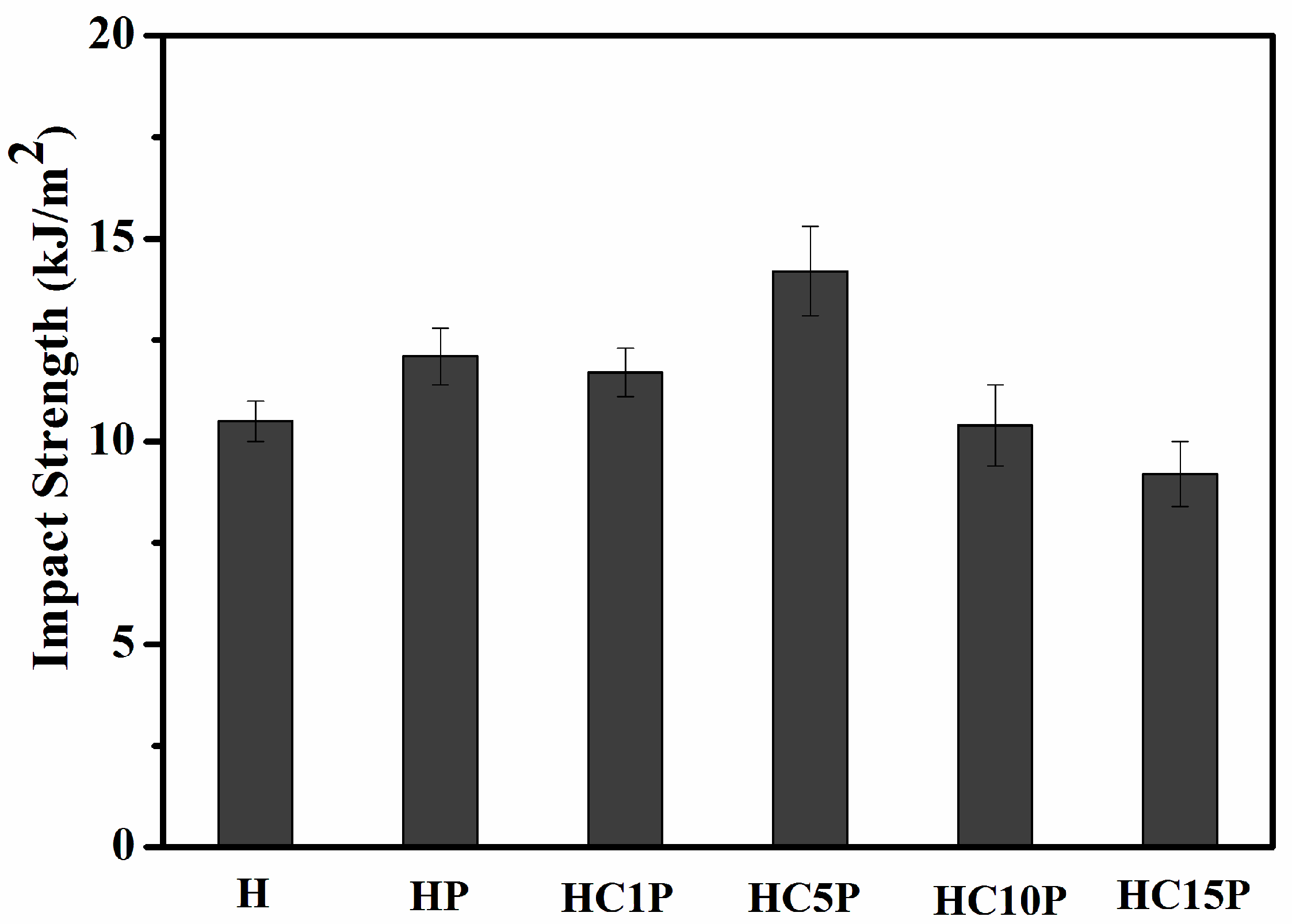
| Abbreviation | Composition (Weight Ratio) | Processing Method | ||
|---|---|---|---|---|
| HDPE | Nano-CaCO3 | POE | ||
| H | 100 | 0 | 0 | / |
| HP | 95 | 0 | 5 | / |
| HC | 95 | 5 | 0 | / |
| HC1P | 90 | 1 | 10 | Two-step process |
| HC5P-a | 90 | 5 | 10 | One-step process |
| HC5P | 90 | 5 | 10 | Two-step process |
| HC10P | 90 | 10 | 10 | Two-step process |
| HC15P | 90 | 15 | 10 | Two-step process |
| Sample | Contact Angle (°) | Surface Tension (mN/m) | |||
|---|---|---|---|---|---|
| Water | Diiodomethane | ||||
| HDPE | 95.7 | 69.9 | 19.90 | 6.70 | 26.60 |
| POE | 106.8 | 78.4 | 18.88 | 2.92 | 21.80 |
| nano-CaCO3 | 105.2 | 66.2 | 26.93 | 1.32 | 28.25 |
| Pairs | (mN/m) | Predictive Morphology | |
|---|---|---|---|
| HDPE/POE | 1.52 | −1.76 | Core–shell |
| HDPE/nano-CaCO3 | 4.69 | ||
| POE/nano-CaCO3 | 2.00 |
| Sample | Crystal Size/nm | Crystallinity (%) | ||
|---|---|---|---|---|
| L(110) | L(200) | L(020) | ||
| H | 16.53 | 14.94 | 18.54 | 65.13 |
| HP | 17.54 | 14.34 | 16.84 | 60.27 |
| HC1P | 20.10 | 16.77 | 17.89 | 60.92 |
| HC5P | 21.11 | 17.09 | 16.38 | 69.09 |
| HC5P-a | 23.18 | 16.1 | 15.79 | 71.44 |
| HC10P | 16.53 | 14.94 | 18.54 | 65.13 |
| HC15P | 17.54 | 14.34 | 16.84 | 60.27 |
| Sample | Yield Strength | Tensile Modulus | Breaking Strength | Elongation at Breaking |
|---|---|---|---|---|
| (MPa) | (MPa) | (MPa) | (%) | |
| H | 21.87 ± 1.12 | 1429.31 ± 19.27 | 31.33 ± 1.24 | 521.17 ± 21.45 |
| HC5P-a | 20.42 ± 0.92 | 1424.56 ± 21.45 | 28.34 ± 1.42 | 505.45 ± 19.45 |
| HC5P | 22.98 ± 1.22 | 1435.34 ± 23.05 | 42.98 ± 0.92 | 661.76 ± 25.47 |
| Sample | Yield Strength | Tensile Modulus | Breaking Strength | Elongation at Breaking |
|---|---|---|---|---|
| (MPa) | (MPa) | (MPa) | (%) | |
| H | 21.87 ± 1.12 | 1429.31 ± 19.27 | 31.33 ± 1.24 | 521.17 ± 21.45 |
| HP | 18.53 ± 1.65 | 1439.25 ± 23.26 | 28.52 ± 1.50 | 560.23 ± 22.75 |
| HC1P | 20.63 ± 1.24 | 1406.76 ± 21.57 | 29.70 ± 1.52 | 575.75 ± 22.88 |
| HC5P | 20.67 ± 1.45 | 1396.97 ± 20.57 | 35.17 ± 1.42 | 630.08 ± 20.74 |
| HC10P | 21.56 ± 1.28 | 1302.45 ± 19.28 | 30.12 ± 2.75 | 555.46 ± 24.57 |
| HC15P | 21.69 ± 1.54 | 1269.30 ± 20.84 | 26.86 ± 1.81 | 523.92 ± 20.11 |
Disclaimer/Publisher’s Note: The statements, opinions and data contained in all publications are solely those of the individual author(s) and contributor(s) and not of MDPI and/or the editor(s). MDPI and/or the editor(s) disclaim responsibility for any injury to people or property resulting from any ideas, methods, instructions or products referred to in the content. |
© 2024 by the authors. Licensee MDPI, Basel, Switzerland. This article is an open access article distributed under the terms and conditions of the Creative Commons Attribution (CC BY) license (https://creativecommons.org/licenses/by/4.0/).
Share and Cite
Liu, W.; Wang, L.; Zhang, X.; Huang, H.; Liu, Y.; Min, M. Exploring the Effects of Nano-CaCO3 on the Core–Shell Structure and Properties of HDPE/POE/Nano-CaCO3 Ternary Nanocomposites. Polymers 2024, 16, 1146. https://doi.org/10.3390/polym16081146
Liu W, Wang L, Zhang X, Huang H, Liu Y, Min M. Exploring the Effects of Nano-CaCO3 on the Core–Shell Structure and Properties of HDPE/POE/Nano-CaCO3 Ternary Nanocomposites. Polymers. 2024; 16(8):1146. https://doi.org/10.3390/polym16081146
Chicago/Turabian StyleLiu, Wei, Lumin Wang, Xun Zhang, Hongliang Huang, Yongli Liu, and Minghua Min. 2024. "Exploring the Effects of Nano-CaCO3 on the Core–Shell Structure and Properties of HDPE/POE/Nano-CaCO3 Ternary Nanocomposites" Polymers 16, no. 8: 1146. https://doi.org/10.3390/polym16081146






